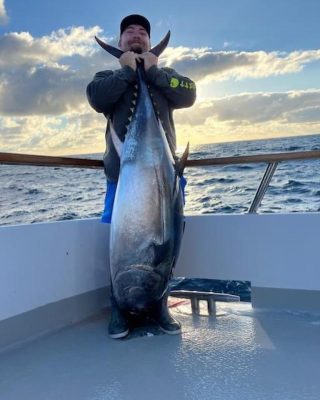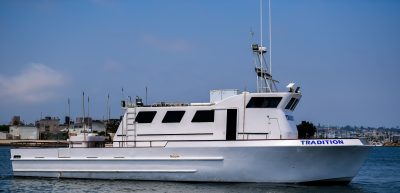When La Mesa resident Frank Ursitti became the managing partner of Point Loma-based H&M Landing in April, he had already been in the sportfishing and ecotourism business for 39 years.
“I’ve been a career Southern California sportfishing guy,” he said. “It’s been an incredible ride, that’s for sure.”
As the man who is now in charge of the day-to-day operations of the West Coast’s largest and most diversified fleet of sportfishing boats, Ursitti is already making changes to grow H&M by expanding its school whale-watching program to San Diego.
Ursitti founded Channel Islands Whale Watching in 2000 which offered whale watching and natural tours around Channel Islands National Park.
“Our business is hugely successful up north and now given the opportunity here as managing partner of H&M, we’re going to put some of those programs in place –– i.e. our school program for whale watching.”
The whale-watching school program will offer teachers both pre- and post-trip curriculum that meets state standards so their students will be well-prepped when they come as well as activities when they return to the classroom, Ursitti said.
Each boat has naturalists on board to talk about the natural history, population decline and over-harvesting of whales. Boats also include a library, models of whales (Ursitti calls them “action figures”); and will soon have samples of baleen and krill for students to learn about how whales feed.
Whale conservation is one of the biggest lessons for students who learn about how the grey whale was hunted to the brink extinction twice and how protecting whale species is positive for both environmental and economical reasons.
“If you really look at it on a global scale, whales are worth far more today in terms of ecotourism dollars than they ever were as a product for oil, food, etc. So we talk about the importance of that conservation.”

“Growing up in this industry, we never would see [whale migrations] occurring on a consistent basis, but we have in recent decades,” he said. “Whaling, globally, is at an all-time low and that certainly sets the stage for species recovery.”
Modern production of products is also a reason for whale populations returning. “We produce so many things synthetically that we don’t need to go after whales for oil or for meat.”
And with more whales there are more tourists wanting to experience them in the ocean.
“Ecotourism is booming here in Southern California. Everyone wants to go out and see nature in the wild –– not necessarily in a wild animal park or in a zoo –– and there’s no greater experience than whale watching here in Southern California. Here you can go out and see an animal that knows no boundaries, knows no barricades and is doing what it does in its natural environment.”
The whale-watching program for schools is new to the Point Loma boats at H&M Landing, but the company has offered another program for schools here for almost 30 years –– the Marine Floating Lab. “[The program] is one of the most tactile approaches to introducing students to the marine environment,” said Ursitti.
Students learn physical oceanography by using a mud grabber for sediment samples; a secci disc device to measure water clarity; a sounding to check depth; and an anemometer for wind speed.
Students learn about ocean biology by dredging for organisms; using a touch tank to handle animals collected with an otter trawl; and viewing plankton under a microscope in a lab. “Students will break down a sample of water and they can see exactly what’s in there as far as phyto or zooplankton so they can get a really good idea of the food chain.”

The Floating Lab is a popular field trip that around 10,000 students experience annually, Ursitti said. “We have students that come from the desert, Arizona, north of Orange County, San Diego County, of course. We have a group of 300 students [from Oceanside] coming in two weeks and we’ll use multiple boats.”
The success of the Floating Lab gives Ursitti confidence that the whale-watching program will also be a big hit with schools and teachers wanting to give students something memorable and educational in a field trip experience. Most of all, though, it is the now-predictable whale migrations that make it possible to offer students and tourists a first-class whale-watching experience.
“January into April, it would be very rare not to see a grey whale,” he said. “As we get into the summertime, we have fin and blue whales. We see southbound pods on their way to Baja Mexico calving lagoons. March and April will see northbound grey whales with mothers and calf pairs and spring to early summer we see humpback whales in our region.”
Click here For more information on H&M Landing’s school programs, whale-watching tours or sportfishing trips, or call 619-222-1144.
Original article by Jeff Clemetson | La Mesa Courier
Click here to see the full article.



